Final report for FNE19-929
Project Information
Robariah Farms, a New England farm specializing in local, pasture-raised, kosher-certified meat, extended its multi-year research in the commercial viability of local, kosher processing.
Issue. The underlying issue we seek to address is how to produce economically viable, kosher-certified chicken for commercial sale that is processed locally.
Goal. Our goal for this current round of research was to adapt a local, state- or USDA-certified poultry processing facility with the equipment, personnel, and resources that are required to produce a kosher-certified chicken product.
Methods. We worked with a local facility to incorporate the following modifications to process chicken that is 100% kosher-certified and state-certified for commercial sale:
- Purchase and use of specialized kosher processing equipment. This includes using a commercial-grade dry plucker to avoid scalding birds, which is prohibit in kosher processing.
- Hiring certified personnel who are trained in kosher processing:
- Shochet ("slaughterer") - The certified ritual slaughter who follows specific guidelines to ensure minimal pain to the animal. This person ensures there is no scalding of the bird and conducts specific checks on the organs during evisceration to ensure the animal's health.
- Mashgiach (supervisor) - The trained person who oversees that birds are soaked in water for 30 minutes and salted for 60 minutes, key requirements in kosher processing to help remove blood from the animal.
- Hiring additional personnel to support dry plucking
This research built on the analysis we completed in past years that evaluated the economic viability of kosher-processing chicken using
- Existing kosher-certified, large-scale industrial (3K-30K+ chickens/day), USDA-inspected poultry processing facilities located 250+ miles away from our local production location.
- Local, non-kosher, small-scale (up to 300 chickens/day), mobile poultry processing units that we adapt to support kosher-certified chicken.
Outcomes. This research revealed that local, kosher processing is not economically viable with the current type of equipment (specifically the dry pluckers) and resources we used. We were able to process up to 100 kosher-certified chickens in one day. We need to process at least 200 kosher-certified chickens per day reduce processing costs that allows for us to achieve an economically viable commercial product.
Sharing Results. Project results were presented at multiple local community forums that focus on sustainable agriculture and local food systems.
As owner of Robariah Farms, we propose building on recently completed research (conducted with funding from a 2015 SARE Farmer Grant) to address this issue. Leveraging a local, state-certified poultry processing facility and integrating required elements of kosher processing (ritual slaughterer (shochet) to kill and supervise; dry plucking without scalding; soaking and salting), we will pilot a higher capacity model of kosher poultry processing that can be economically viable.
Our technical advisor is the experienced owner of a local, state-certified poultry processing facility. He will manage the processing. We will use low-volume dry pluckers and a high volume industrial dry-plucker integrated into the facility. We will collect data at several points to analyze production efficiency and cost effectiveness. We will compare results against 1) a non-local, industrial kosher facility; 2) a local, non-kosher facility; and 3) local, kosher processing previously piloted.
In New England, the absence of local kosher poultry processors is a significant problem with market demand rising for sustainably raised, locally produced kosher meat. The problem is compounded by the current issue of cost effectiveness and production efficiency that small-scale commercial producers face in accessing local kosher processing. The following market research supports this problem:
- “Limited access to slaughter and processing facilities, especially those with Federal or State inspection, continues to be challenging for farmers seeking to satisfy consumer demand for local meat and poultry products….Farmers may have to drive several hours or longer to the closest inspected processor or one with the desired certifications, skills, or services.”
- There is “significant demand for slaughter and processing services, and potential supply of inputs for slaughter/processing services. 59% of the farmers who responded said they would more than double their herds with additional processing capacity….Location is the major factor for farmers deciding where to bring their animals for slaughter.”
- 44% of the kosher market is Jewish consumers. In Massachusetts and New England, 4-5% of the population is Jewish—almost double the national percentage. While 15% of those who purchase kosher products do so for religious reasons, most who seek out kosher products buy the items for food quality (62%), healthfulness (51%), and food safety (34%). 19% of the kosher market is Muslim who consume food certified as Halal.
While local, commercial growers may choose to transport their poultry to a non-local kosher processor, the consequences have negative impacts:
- Increased health/safety risk and higher stress levels among chickens
- Increased carbon emissions and environmental pollutants from long transport
- Diversion of financial resources from local rural communities
- Substantial operational planning resources to access a large-scale facility
Massachusetts poultry stakeholders have been convening over the past several years to address the high demand for, but low supply of, locally raised, sustainable meat. Large institutions such as the University of Massachusetts dining facilities, along with numerous growers and local food organizations, recognize that there is great opportunity for the local sale of locally raised meat. However, the lack of local processing facilities undermines this opportunity. The demand across New England for local kosher meat is part of this larger demand and opportunity. By developing a commercially viable model for local processing of kosher poultry we will be able to demonstrate how other stakeholders can achieve success.
Our proposed solution builds on many efforts to address the problem of providing a local source of sustainably raised, kosher meat. Efforts have been made in three key areas: 1) piloting local kosher processing using a mobile poultry processing unit with research funding from a previous SARE Farmer Grant FNE15-827; 2) commercial enterprises now providing “sustainable” kosher meat; and
3) the demonstrated need for more local processors in our region.
Key Area #1. In 2015, we adapted state-certified local poultry processing facilities to integrate traditional kosher slaughtering practices and equipment. We conducted a total of seven separate processing days. We processed about 50 birds on the first two days, about 100 birds on the third and fourth days, and 150 on the fifth and sixth days, totaling about 600 chickens total. In addition, we processed 28 turkeys on a seventh processing day. For each processing day, we hired the same independent kosher certification agency, which included a shochet (ritual slaughter) to oversee processing and ensure that strict kosher techniques were applied.
Due to the prohibition of scalding the meat during processing, a total of four different commercial-scale dry plucking machines were piloted to explore the production efficiency, cost, and plucking quality each provided.
Each of the following machines still required some hand-plucking to remove the final 5-20% of feathers (especially on the wings).
1) a heavy-duty machine where replaceable discs rotated quickly to strip feathers. This machine proved costly and ineffective in its plucking.
2) Two Fowl Plucker machines proved safe, cost-effective , and reliable, though plucking took about 4 minutes per bird.
3) standard rotating tub with water sprayer and interior rubber fingers. This proved convenient but required pre-soaking in cold water. The result was a 50-75% plucked chicken.
4) Ashley Manual Plucker Model #15 (21 inch) proved most effective (about 95% of feathers in 4 min per bird), relatively safe and affordable. However, given that one person can pluck one chicken at a time, the overall economic viability of this machine is not sufficient.
We determined that kosher processing currently requires about twice as much time and increased human labor when using local small-scale poultry processing facilities. The key bottleneck in this limited production efficiency model is the plucking. This is compounded by additional environmental challenges that can come with open-air processing. From hot sunny days or colder rainy days, it is important to have a condition-controlled indoor facility for processing.
To create a successful model, we plan to outfit our technical advisor's processinng facility with the equipment needed to support kosher processing. We will purchase a higher capacity dry plucker (through separate non-SARE funding) that can be fully integrated into an the indoor processing facility. To do this, a small shipping container space will also be purchased and retrofitted to house the dry plucker according to code. The space will have a connecting passage such that plucked poultry can link directly into the existing assembly line.
We will also further pilot kosher processing using currently owned low-volume pluckers at the same local facility. The production efficiency and resulting economic viability will be analyzed and compared.
Key Area #2. Over the past decade a number of commercial enterprises have manifested to respond to the rising demand for sustainable kosher meat.
1) The first group includes large-scale producers that specifically cater to consumers seeking a kosher product. These producers do not employ sustainable growing practices.
2) A second group includes distributors of sustainably grown, kosher meat. These enterprises source their meat from growers that use sustainable farming practices, transport live animals to a kosher processing facility, and ship to customers nationwide.
3) Robariah Farms represents a third type of enterprise. We raise our animals using sustainable grazing practices and sell directly to our local communities. The absence of local kosher processing is our biggest limitation.
Key Area #3. A 2013 report from the USDA’s Economic Research Service noted: “In recent decades, consumers have become increasingly interested in local food, including local meat and poultry. To meet this demand, local meat producers need access to appropriately scaled processing facilities….Farmers and others market participants suggest that limited processing infrastructure is a bottleneck restricting the flow of local meat and poultry to market, and they call for more plants to be built.”
Since 2012, my wife and I have operated a local, pastured raised, kosher meat business, specializing in poultry. We sell retail via a CSA model and wholesale to regional co-ops, restaurants, and institutions across New England. Our production volumes doubled each year, until 2017 when we paused operations to address the challenge and need for higher volume kosher processing. In 2017-2020, we began to work cooperatively with other families to begin building a cooperative business model in which buyers contribute time, resources, and finances to the enterprise. This model builds community buy-in. We operate on 5-7 acres of land leased from a neighbor. In addition, we also maintain other full-time farm and marketing jobs to supplement our income.
Our technical advisor owns Reed Farm and has managed a state-certified mobile poultry processing unit for the past several years at the New England Small Farm Institute. He now owns and operates his own state-certified (soon to be USDA-certified) poultry processing facility near Robariah Farms to support local poultry growers with access to local processing. He has managed the kosher poultry processing previously conducted locally by Robariah Farms.
Cooperators
- (Educator and Researcher)
- - Technical Advisor
Research
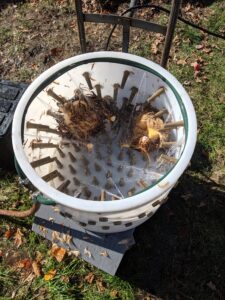
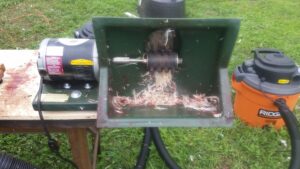
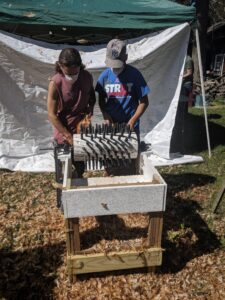
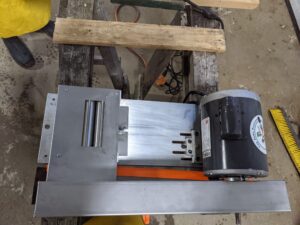
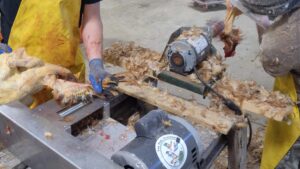
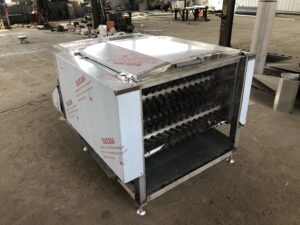
Our project goal is to achieve a high enough level of operational efficiency that the production of locally processed, kosher poultry is economically viable for commercial purposes. To accomplish this, in 2019 we conducted a series of processing batches to provide ample data in support of commercial production volumes. We raised poultry in three (3) distinct batches during the 2019 grow season. Batch #1 consisted of 100 chickens; Batch #2 consisted of 100 chickens; and Batch #3 consisted of 35 chickens and 15 turkeys. Each batch was processed in 1 day.
In 2020, we conduct one batch of 100 chickens.
These volumes and number of groupings were identified in consultation with our ritual kosher slaughterer and our technical advisor, based upon his expertise of the potential production volumes and costs associated with non-kosher local poultry processing.
The batches consisted of a heritage-based meat bird, which took about 10 weeks to reach their peak slaughter weight. Data were collected at multiple points during the processing of each batch. Quantifiable data including processing time, volumes, and manual labor were key data areas that we obtained at multiple points during processing. Contextual data were identified to support the measured data. For example, processing configurations were modified between batches to increase or keep stable processing efficiency. We also utilized 3-4 dry pluckers, though only two were in constant use. This allowed for machines to cool or for people to use the machine of their choice.
As we knew, a critical piece of equipment necessary for production efficiency in kosher processing is a dry plucker. This is required due to the prohibition of scalding the birds during processing, which is commonly done in conventional non-kosher processing prior to wet plucking. While we had identified a high capacity, industrial-strength dry plucker that our technical advisor believed would provide for comparable production efficiency (as achieved through scalding and wet-plucking), that model is hardly available in the US and no data exists to support its efficiency as a dry plucker. As a result, we designed and constructed our own higher capacity dry plucker, which was used in conjunction with already own lower strength dry pluckers.
We are analyzing data against two control groups of existing data. Our technical advisor is supporting analysis of data against the first control group, which is local, non-kosher processing. He is providing data concerning production volumes, processing times, labor involvement, and costs based on his management of non-kosher processing using similar facility conditions.
The second control group to which project data is being compared is kosher, non-local processing. In past years Robariah Farms has transported poultry to industrial-scale kosher processors in Pennsylvania and New York State. The production volumes, time efficiency, and associated costs collected from this processor provide a useful comparative data set to discuss the advantages and disadvantages of different small-scale kosher processing models.
In 2021, our local kosher processing occurred indoors at nearby state-licensed poultry processing facility. A new type of machine was used in addition to two previously used machines. The three machines together provided similar results as in prior trials. At best 125 Freedom Ranger chickens were plucked in a 4.5 hours period. Soaking, salting, and packing required another 4 hours. Our labor force included about nine personnel, about 3x the number that would have been needed in non-kosher processing at the facility. We processed about 1/4 of the volume that 1/3 of the labor force could have done in non-kosher processing. This is entirely due to 1) the use of individual pluckers requiring one person per machine that cleans 90% of the bird in about 4-5 minutes, 2) the need for two people conducting final hand-plucking, and 3) the requirement of two kosher-specific personnel to certify the kosher process.
We had planned to test another higher volume freestanding plucker in 2022. It was purchased directly from a manufacturer in China. It has the capacity to pluck up to 20 birds in 2-3 minutes if scalded. However, we hoped that it will provide positive results for non-scalded birds that we would use for kosher processing. Unfortunately due to shipping challenges, this machine was not piloted prior to the submission of this report.
What Worked
In processing each batch, the critical data we measured were dry-plucking times. While our goal was to achieve a plucking time of 2 minutes or less per bird, the fastest time we achieved was 5 minutes for one bird using the Fowl Plucker machine.
- This rate was consistently achieved by multiple trained people using the Fowl Plucker machines (see prior images). We had two of those machines, which allow for one person per machine.
- At 5 minutes per bird and two Fowl Pluckers going, we plucked 100 birds in about 4.5 hours.
- Given the additional steps required for kosher processing (namely soaking for 30 minutes and salting for 60 minutes), total processing time took about 8 hours total, plus clean-up.
- We had a crew of 6-8 people with varying degrees of poultry processing experience.
In addition, tried a new model called the Pro Goose Plucker, also manufactured by The Fowl Plucker. This machine yielded similar results. If anything the machine was less efficient. Due to its rolling pins technique, it proved effective for plucker larger feathers on the birds. However, the machine regularly got plugged up when too many feathers got caught in the machine.
Features of the Fowl Plucker:
- Affordable at $695 per machine. New sets of 14 fingers are $39.
- Easy to use, reliable, and light weight
- Safe to touch fingers while spinning
- Rarely tears poultry skin
Limitations of the Fowl Plucker:
- Rubber fingers must be replaced every 20-25 birds.
- Only one person can use it at a time given it's drum is 4" wide by 2" in diameter.
- Motor runs hot and must be turned off to cool
- Cannot be used to dry pluck turkeys or other larger poultry
Features of the Pro Goose Plucker:
- Freestanding and mobile
- Rolling pins are stainless steel and do not require replacement
- Effective for pulling larger feathers
- Rarely tears poultry skin
Limitations of the Pro Goose Plucker:
- Gets plugged up regularly, requiring powering off the machine and clearing the space between the two rolling pins
- Only one person can operate it a time
- Rolling pins are a hazard should the operator's finger get pinched
- Cannot be used to dry pluck turkeys or other larger poultry
WHAT COULD WORK
Extensive market research continues to be collected on commercial pluckers that could achieve faster dry plucking times. Our research has yielded the following findings:
- Larger manual drum dry pluckers on the market (e.g., with drum lengths of 1-2 feet) that would conceptually work and be affordable in small-scale poultry operations have never been used for dry plucking and are not recommended for dry plucking purposes. We experimented with a used Ashley Manual Picker but its electrical set-up was malfunctioning. In past years we successfully used this model to dry pluck turkeys. Additional research is needed for how efficient this machine would be with chickens.
- Industrial kosher poultry processing plants use a high-capacity plucking tunnel to cleanly remove feathers. Birds are passed through the plucking tunnel (think of a car moving through a car wash) while hanging on an overhead conveyor. We research two such tunnel systems and received bids for installing them. However, the high costs of these systems are not cost-effective for smaller poultry producers.
- Industrial high-capacity, free-standing plucking machine with multiple internal rotating drums. While not designed specifically for dry plucking, their mobility to install in a small- to medium-scale poultry processing facility is helpful. Also, its high capacity may provide for effective dry plucking even at higher plucking times than when scalded. We plan to pilot this in 2023.
What Did Not Work
We designed and developed a manual plucker with a 2-foot long drum that is about 1-foot in diameter (see previous image). The concept with this plucker was to be able to dry pick two chickens at one time with two people holding the chickens. The machine was well built but lacks adjustable configurations at present. Currently the drum spins too fast and as a result tears the skin. Work is needed to add a speed controller in order that the optimal rate can be reached. If this prototype can be customized to work, it may also provide a starting point from adapting the machine or scaling it up to process more birds at one time.
While the combination of Fowl Pluckers and the Pro Goose Plucker was a reliable set up, a maximum of 125 Freedom Ranger chickens was achieved on one day of processing. This required 6 additional people in the labor force.
Attempts to increase efficiency were not achieved. This accounts for a new freestanding plucker machine that was used in combination with two previously used machines.
More research is required to develop a machine that is both efficient and cost-effective for dry plucking and kosher processing up to 500 birds in one day in a small-scale processing facility. Alternatively, more research is needed to determine how industrial dry plucking systems could be affordably reconfigured to work in a smaller-scale processing facility.
For now, it remains that local kosher processing can achieve up to 125 birds (a negligible increase from the 100 previously stated) in one 8 hr day (from kill to packaging) vs. non-local industrial kosher processing which can achieve several thousand birds in one day.
Our local business is committed to continuing its research to meet the demand for local kosher meat.
Education & Outreach Activities and Participation Summary
Participation Summary:
Consultations. We consulted with three different parties who were interested in producing local, kosher processing. We provided them with the requirements and challenges they would encounter, and to overcome them.
On-site Tours. We conducted two on-site farm tours for a national Jewish food recipe company and a graduate student at the UMass Sustainable Food and Farm Program.
Field Days. We conducted 4 field days to locally process kosher-certified chicken. Community members gathered to observe and participate in the process.
Presentations. We conducted three presentations about our research, including to the Harold Grinspoon Foundation, the Local Farmer Awards, and to Abundance Farm, a project of Congregation B'nai Israel in Northampton.
Demonstrations. We conducted 4 demonstrations of our locally processed, kosher-certified chicken. Community members gathered to observe and participate in the process. One demonstration include a high school group study sustainability and social justice.
Publications. We distributed processing news through our local e-newsletter to farm patrons.
Learning Outcomes
Understanding the practices and principles of kosher poultry processing and how it aligns with values in supporting local agriculture
Project Outcomes
It is clear from feedback that there is incredible appreciation for local, kosher meat. However, the challenge remains about how to produce it cost-effectively. An approach of producing both kosher and non-kosher local meat may be more cost-effective as a business model in that processing non-kosher meat is about half the cost. Nevertheless, with an incredible demand, a huge invested customer base, and many dedicated collaborators, the prospect of creating local, kosher poultry is a positive and persistent one.
Our study's approach was in-depth and yielded sobering truths. There is a huge gap in existing commercial capabilities to support commercial poultry producers aiming to kosher process up to 500 birds in a day. The economies of scale lean towards backyard grows (processing up to 50 birds) and large commercial growers processing thousands of birds daily. There is additional need for ingenuity to develop a solution to fill this gap, one that provides a return on investment and allows for producers to scale up to an economically viable size that is can be supported through sustainable growing practices.
An additional freestanding plucking machine was identified and acquired, though not in time to test before the end of 2022. In conventional plucking systems in which the birds are scalded, this machine allows for plucking of up to 20 birds at one time in about 2-3 minutes. We plan to test this machine with non-scalded birds in an attempt to improve kosher processing efficiency.